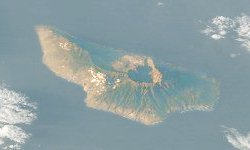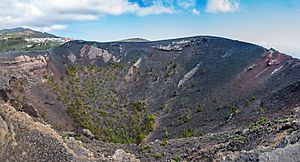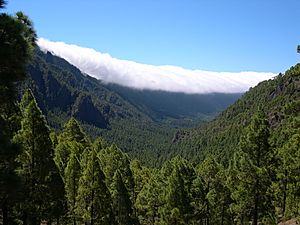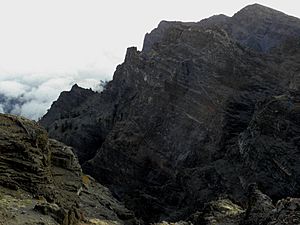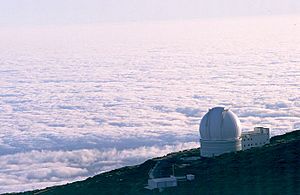La Palma facts for kids

Satellite view of La Palma
|
|
 |
|
| Geography | |
|---|---|
| Location | Atlantic Ocean |
| Coordinates | 28°40′N 17°52′W / 28.667°N 17.867°W |
| Archipelago | Canary Islands |
| Area | 708.32 km2 (273.48 sq mi) |
| Coastline | 166 km (103.1 mi) |
| Highest elevation | 2,423 m (7,949 ft) |
| Highest point | Roque de los Muchachos |
| Administration | |
|
Spain
|
|
| Autonomous Community | Canary Islands |
| Province | Santa Cruz de Tenerife |
| Capital city | Santa Cruz de La Palma |
| Largest settlement | Los Llanos de Aridane (pop. 20,467 (2019)) |
| Demographics | |
| Demonym | palmero/a |
| Population | 82,671 (2019) |
| Pop. density | 116.7 /km2 (302.3 /sq mi) |
| Languages | Spanish, specifically Canarian Spanish |
| Ethnic groups | Spanish, other minority groups |
| Additional information | |
| Time zone |
|
| • Summer (DST) | |
La Palma, also San Miguel de La Palma, is the most north-westerly island of the Canary Islands, Spain. La Palma has an area of 708 square kilometres (273 sq mi) making it the fifth largest of the seven main Canary Islands. The total population at the start of 2019 was 82,671, of which 15,716 lived in the capital, Santa Cruz de la Palma and about 20,467 in Los Llanos de Aridane. La Palma has "sister city" status with El Dorado Hills, California. Its highest mountain is the Roque de los Muchachos, at 2,423 metres (7,949 ft), being second among the peaks of the Canaries only to the peaks of the Teide massif on Tenerife.
In 1815, the German geologist Leopold von Buch visited the Canary Islands. It was as a result of his visit to Tenerife, where he visited the Las Cañadas caldera, and then later to La Palma, where he visited the Taburiente caldera, that the Spanish word for cauldron or large cooking pot – "caldera" – was introduced into the geological vocabulary. In the center of the island is the Caldera de Taburiente National Park; one of four national parks in the Canary Islands.
Contents
Origins and geology
La Palma, like the other islands of the Canary Island archipelago, is a volcanic ocean island. The volcano rises almost 7 km (4 mi) above the floor of the Atlantic Ocean. There is road access from sea level to the summit at 2,426 m (7,959 ft), which is marked by an outcrop of rocks called Los Muchachos ("The Lads"). This is the site of the Roque de los Muchachos Observatory, one of the world's premier astronomical observatories.
La Palma's geography is a result of the volcanic formation of the island. The highest peaks reach over 2,400 m (7,874 ft) above sea level, and the base of the island is located almost 4,000 m (13,123 ft) below sea level. The northern part of La Palma is dominated by the Caldera de Taburiente, with a width of 9 km (6 mi) and a depth of 1,500 m (4,921 ft). It is surrounded by a ring of mountains ranging from 1,600 m (5,249 ft) to 2,400 m (7,874 ft) in height. On its northern side is the exposed remains of the original seamount. Only the deep Barranco de las Angustias ("Ravine of Anxiety") ravine leads into the inner area of the caldera, which is a national park. It can be reached only by hiking. The outer slopes are cut by numerous gorges which run from 2,000 m (6,562 ft) down to the sea. Today, only a few of these carry water due to the many water tunnels that have been cut into the island's structure.
From the Caldera de Taburiente to the south runs the ridge Cumbre Nueva – the New Ridge, which despite its name is older than the Cumbre Vieja – Old Ridge. The southern part of La Palma consists of the Cumbre Vieja, a volcanic ridge formed by numerous volcanic cones built of lava and scoria. The Cumbre Vieja is active – but dormant, with the last eruption occurring in 1971 at the Teneguía vent which is located at the southern end of the Cumbre Vieja – Punta de Fuencaliente, (The Point of the Hot Fountain). Beyond Punta de Fuencaliente, the Cumbre Vieja continues in a southerly direction as a submarine volcano.
Volcano
Like all of the Canary Islands, La Palma originally formed as a seamount through submarine volcanic activity. La Palma is currently, along with Tenerife, the most volcanically active of the Canary Islands and was formed three to four million years ago. Its base lies almost 4,000 m (13,123 ft) below sea level and reaches a height of 2,426 m (7,959 ft) above sea level. About a half a million years ago, the Taburiente volcano collapsed with a giant landslide, forming the Caldera de Taburiente. Erosion has since exposed part of the seamount in the northern sector of the Caldera. Since the Spanish have kept records, there have been seven eruptions – all of which have occurred on the Cumbre Vieja:
- 1470–1492 Montaña Quemada
- 1585 Tajuya near El Paso
- 1646 Volcán San Martin
- 1677 Volcán San Antonio
- 1712 El Charco
- 1949 Volcán Nambroque at the Duraznero, Hoyo Negro and Llano del Banco vents
- 1971 Volcán Teneguía
During the 1949 eruption – which commenced on the fiesta of San Juan (St John) 24 June 1949 at the Duraznero, and 8 July 1949 Llano del Banco vents on the Cumbre Vieja – an earthquake, with an epicentre near Jedy, occurred. This is considered to have caused a 2.5-kilometre-long (1.6 mi) crack which Bonelli Rubio (1950) named "La Grieta" – (the crack), to form, with a width of about 1 m (3 ft 3 in) and a depth of about 2 m (6 ft 7 in). It attains a maximum displacement of ~4 m (13 ft) in the vicinity of the Hoyo Negro to Duraznero vents. It is not traceable southward from the Duraznero vent. North of the Hoyo Negro it traverses downslope and is traceable for ~1500 m. The total distance from the southern rim of the Duraznero vent to the Llano del Banco is ~4 km. In 1951 Ortiz and Bonelli-Rubio published further information in respect of the eruption and associated phenomena that occurred before and during the eruption. There is no indication that the crack has penetrated the edifice of the volcano, and, due to the absence of Minas Galerias (water tunnels) within the Cumbre Vieja, there is no possibility of examining the internal structure of the flank. Carracedo et al.;. This means that claims that the flank is in danger of failing are unfounded. However the lack of supporting evidence has not stopped claims that the flank is in danger of failing.
Climate
La Palma has a mild and consistent tropical semi-arid climate, which in the Köppen climate classification is represented as BSh. It has significant influences of the mediterranean climate due to its quite wet winters. For a Canary island, the weather is quite cloudy, as La Palma is far more exposed to marine air systems than easterly islands.
| Climate data for La Palma Airport 33m (1981–2010) | |||||||||||||
|---|---|---|---|---|---|---|---|---|---|---|---|---|---|
| Month | Jan | Feb | Mar | Apr | May | Jun | Jul | Aug | Sep | Oct | Nov | Dec | Year |
| Record high °C (°F) | 27.0 (80.6) |
31.0 (87.8) |
32.8 (91.0) |
36.6 (97.9) |
32.4 (90.3) |
29.4 (84.9) |
38.4 (101.1) |
38.0 (100.4) |
36.8 (98.2) |
34.4 (93.9) |
31.6 (88.9) |
28.1 (82.6) |
38.4 (101.1) |
| Mean daily maximum °C (°F) | 20.6 (69.1) |
20.7 (69.3) |
21.2 (70.2) |
21.6 (70.9) |
22.6 (72.7) |
24.1 (75.4) |
25.5 (77.9) |
26.3 (79.3) |
26.6 (79.9) |
25.5 (77.9) |
23.5 (74.3) |
21.8 (71.2) |
23.3 (74.0) |
| Daily mean °C (°F) | 18.1 (64.6) |
18.0 (64.4) |
18.5 (65.3) |
18.9 (66.0) |
20.0 (68.0) |
21.7 (71.1) |
23.1 (73.6) |
23.9 (75.0) |
24.0 (75.2) |
22.8 (73.0) |
20.9 (69.6) |
19.3 (66.7) |
20.8 (69.4) |
| Mean daily minimum °C (°F) | 15.5 (59.9) |
15.3 (59.5) |
15.7 (60.3) |
16.2 (61.2) |
17.4 (63.3) |
19.2 (66.6) |
20.7 (69.3) |
21.4 (70.5) |
21.3 (70.3) |
20.2 (68.4) |
18.3 (64.9) |
16.7 (62.1) |
18.2 (64.7) |
| Record low °C (°F) | 9.4 (48.9) |
10.9 (51.6) |
10.2 (50.4) |
10.0 (50.0) |
11.0 (51.8) |
15.2 (59.4) |
14.9 (58.8) |
16.7 (62.1) |
16.4 (61.5) |
15.3 (59.5) |
10.0 (50.0) |
10.0 (50.0) |
9.4 (48.9) |
| Average rainfall mm (inches) | 49 (1.9) |
57 (2.2) |
33 (1.3) |
19 (0.7) |
7 (0.3) |
2 (0.1) |
1 (0.0) |
1 (0.0) |
12 (0.5) |
41 (1.6) |
70 (2.8) |
80 (3.1) |
372 (14.5) |
| Average rainy days | 5 | 4 | 4 | 3 | 1 | 0 | 0 | 0 | 2 | 5 | 7 | 8 | 40 |
| Mean monthly sunshine hours | 141 | 146 | 177 | 174 | 192 | 188 | 222 | 209 | 187 | 175 | 140 | 138 | 2,106 |
| Source: Agencia Estatal de Meteorología | |||||||||||||
Naming
In Spanish the island is called "Isla de la Palma," and is usually abbreviated to "La Palma," which means the Island of Palms or Palm Island. La Palma is nicknamed "Isla Bonita" ("beautiful island") or "Isla Verde" ("green island").
Government
The island is part of the province of Santa Cruz de Tenerife. The island is divided into 14 municipalities:
| Name | Area (km2) |
Population (2001) |
Population (2011) |
Population (2019) |
|---|---|---|---|---|
| Barlovento | 43.55 | 2,382 | 2,067 | 1,876 |
| Breña Alta | 30.82 | 5,715 | 7,173 | 7,204 |
| Breña Baja | 14.20 | 3,621 | 5,323 | 5,690 |
| Fuencaliente de la Palma | 56.42 | 1,833 | 1,841 | 1,722 |
| Garafía | 103.00 | 1,795 | 1,566 | 1,667 |
| Los Llanos de Aridane | 35.79 | 17,720 | 20,493 | 20,467 |
| El Paso | 135.92 | 6,764 | 7,665 | 7,622 |
| Puntagorda | 31.10 | 1,675 | 1,730 | 2,110 |
| Puntallana | 35.12 | 2,337 | 2,407 | 2,506 |
| San Andrés y Sauces | 42.75 | 5,351 | 4,578 | 4,141 |
| Santa Cruz de la Palma | 43.38 | 17,265 | 16,568 | 15,716 |
| Tazacorte | 11.37 | 5,062 | 4,777 | 4,575 |
| Tijarafe | 53.76 | 2,730 | 2,675 | 2,532 |
| Villa de Mazo | 71.17 | 4,550 | 4,826 | 4,843 |
| Totals | 708.36 | 78,800 | 83,689 | 82,671 |
Economy
The local economy is primarily based on agriculture and tourism. Plátanos (or bananas) are grown throughout the island with many banana farms on the western side of the island in the valley of Los Llanos de Aridane. Other crops include: Strelitzia (bird of paradise) flowers, oranges, avocados and grapes (which grow well in the volcanic soil). The wine from the grapes is prized. Local ranchers herd cows, sheep and goats (from which they make goat cheese).
Fishermen operating from Santa Cruz, Tazacorte, and Puerto Naos catch fish for the local markets.
Flora and fauna
La Palma has abundant plant life, including several endemic species.
Although large areas have been deforested, the upland areas of La Palma retain some of the evergreen temperate cloud forest, or laurisilva (laurel forest), where species of Lauraceae, such as Laurus azorica, Persea indica, and Ocotea foetens are a characteristic component. This is a relic of the Pliocene subtropical forests which used to cover the island.
The Canary Island pine (Pinus canariensis) is found on all of the western Canary Islands, but it is particularly abundant on La Palma. The pine forests are home to two recently discovered and extremely rare La Palma endemics: Lotus eremiticus and L. pyranthus.
Spartocytisus supranubius, a white-flowered broom known locally as Retama del Teide, is native to La Palma and Tenerife, being restricted to the alpine/subalpine habitats present only in these two islands. Like Tenerife, La Palma also has its own alpine violet, Viola palmensis.
Echium pininana (Tree echium) is endemic to La Palma and the tallest species in the genus, reaching over 4 m. It is related to Echium wildpretii ("Tower of jewels") which occurs, with separate subspecies, in the subalpine zone of both Tenerife and La Palma. Both species are monocarpic, producing a massive terminal inflorescence. Echium webbii, a branched shrub with several smaller, dark blue flower spikes, is another island endemic with close relatives on Tenerife.
The daisy family (Asteraceae) comprises several La Palma endemics such as Sonchus palmensis, Argyranthemum haouarytheum Pericallis papyracea and Cheirolophus sventenii.
Several animals are native or endemic to La Palma, including the:
- La Palma giant lizard, believed extinct until rediscovered in 2007
- Western Canaries lizard (Gallotia galloti subspecies palmae)
- Graja (Pyrrhocorax pyrrhocorax barbarus), subspecies of the red-billed chough
- Canary Islands chiffchaff (Phylloscopus canariensis)
- La Palma chaffinch (Fringilla coelebs palmae)
- Western Canary Islands goldcrest (Regulus regulus ellenthalerae)
- Canary Islands quail (Coturnix gomerae), now extinct.
In addition, many other animals have been introduced, including rabbits and Barbary sheep, or aoudads, which have become a serious threat to endemic flora
A biosphere reserve was established in 1983, and extended and renamed in 1997 and 2002
Natural symbols
The official natural symbols associated with La Palma are Pyrrhocorax pyrrhocorax barbarus (Graja) and Pinus canariensis (Canary Island pine).
History
At the time of European colonization, the Canary Islands were inhabited by native Canarians, referred to collectively as Guanches, although the natives of La Palma are more correctly known as Auaritas (See Canary Islands in pre-colonial times). The origin of these natives is unclear but they are believed to share common ancestry with the Berbers of North Africa. The Guanches had a Neolithic culture divided into several clans led by chiefs. Their name for La Palma was Benahoare. The main remnants of this culture are their cave dwellings, enigmatic petroglyphs and paved stone paths through the mountains. After the Spanish occupation of La Palma, the native Canarians vanished by either being killed, sold into slavery or by assimilating into the Spanish population.
It is believed that the Canary Islands were known to the Phoenicians and Greeks, but the earliest written evidence is by the Roman writer Pliny The Elder, who quoted Juba II of Numidia, but Juba's writings were subsequently lost. The Genoese navigator Lancelotto Malocello reached the archipelago in 1312 and remained for two decades until expelled by a native uprising. In 1404 the Spaniards began the conquest of the islands. Though the first landing on La Palma was in 1405, it took until 1493 and several bloody battles until the last resistance of the natives was broken. The conqueror of La Palma was Alonso Fernández de Lugo, who defeated Tanausu, the last king on the island. He ruled the area known as Acero (Caldera de Taburiente). Tanausu was ambushed after agreeing to a truce arranged by Fernández de Lugo and Juan de Palma, a Guanche who had converted to Christianity and who was a relative of Tanausu.
For the next two centuries, settlements on La Palma became rich as the island served as a trading post on the way to the New World. La Palma received immigrants from Castile, Majorca, Andalusia, Portugal and Catalonia.
Religion
The island is predominately Roman Catholic and since 1676, has been known for the festival of Fiestas Lustrales de la Bajada de la Virgen de las Nieves (the bringing down of the Virgin of the Snow, Virgen de las Nieves), which has a rich history, from the time of the Bishop of the Canaries, Bartolomé García Ximénez. The festival features the dancing of "enanos" or midgets. The costumes that people wear have a hole at the top of the hat to allow them to see out, while giving the appearance of dancing midgets. People come from all over the world for the celebration which happens every five years. The image of the Virgin is taken down from her sanctuary (located in a hilly area on the outskirts of Santa Cruz de La Palma) and paraded around the city of Santa Cruz with the festival lasting nearly two weeks before she is returned. The last time this event was performed in 2015 and the next will be in 2020.
The Virgin of the Snow is the patron saint of La Palma. Many women on the island have the name "Nieves" in honor of this. Every 5 August the annual festival of the Virgin is celebrated.
Transport
La Palma has a road network of some 1,200 km (746 mi). All the main roads are asphalted and in a good state, although there are many sharp bends, some very narrow. In order to reach some small hamlets in the north of the island it is necessary to travel on earth tracks. A good paved road approximately 180 km (112 mi), circumscribes the island. Several bus routes exist that unite the main localities on the island.
There is a road that runs from Los Llanos de Aridane to the capital city of the island Santa Cruz de La Palma (known by locals as simply Santa Cruz). This road is a two-lane highway that includes a pair of two-lane tunnels that go right through the top of the mountain. The older tunnel is shorter (1,100 m (3,609 ft)) and higher than the newer tunnel (2,880 m (9,449 ft)). When traveling from one side of the mountain to the other it is common to enter one side in complete clouds (the east side) and come out to the sunny side (western side). This is due to the clouds not being able to cross the mountains, an effect caused by the counter trade wind.
La Palma Airport serves the island, and several airlines run services to and from it. There is also ferry service to and from the island in the city of Sta. Cruz.
Water tunnels
The most famous structures of La Palma are the minas galerias (water tunnels) which carry the water from sources in the mountains to cities, villages and farms (nowadays mainly banana plantations). La Palma receives almost all of its water supply due to the mar de nubes (sea of clouds), stratocumulus cloud at 1,200 m (3,937 ft)-1,600 m (5,249 ft) altitude, carried on the prevailing wind which blows from the north-east trade winds. The water condenses on the long needles of the trees and other vegetation, it then either drips onto the ground or runs down the trunk etc., into the ground. Eventually it collects inside the rock-strata, and is then drained via the galerias into aqueducts and pipes for distribution. The galerias have been cut into the rocks over centuries. To visit the galerias a permit is required. It is possible to walk alongside many of the aqueducts, a popular activity for tourists (similar to the levadas of Madeira). The tour to the Marcos y Corderos waterfall and springs is also popular.
There is an extensive network of irrigation canals in the valley of Los Llanos de Aridane. These canals carry water from the mountains throughout the valley and allow for the cultivation of bananas, avocados, flowers, and other plants. Each farmer gets a scheduled "turn" to fill an irrigation tank with water 24 hours of the day. If a farmer's turn is at 2 AM he will wake up and make sure to fill his tank when possible so as to have sufficient water for his farm.
These round tanks typically gather moss and lilly pads upon which frogs make their habitat.
Observatories
Due to the location of the island and the height of its mountains, some 2,400 m (7,874 ft) above sea level, a number of international observatories have been built on the Roque de los Muchachos. The particular geographical position and climate cause clouds to form between 1,000 m (3,281 ft) and 2,000 m (6,562 ft), usually leaving the observatories with a clear sky. Often, the view from the top of the volcano is a sea of clouds covering the eastern part of the island. Telescopes at the observatory include:
- The Isaac Newton Group of Telescopes (ING) operates three telescopes: the 4.2 m (14 ft) William Herschel Telescope, the 2.5 m (8 ft 2 in) Isaac Newton Telescope and the 1 m (3 ft 3 in) Jacobus Kapteyn Telescope.
- The 2.5 m (8 ft 2 in) Nordic Optical Telescope (NOT).
- The 1 m (3 ft 3 in) Swedish 1-m Solar Telescope (SST) operated by the Institute for Solar Physics.
- The 0.45 m (1 ft 6 in) Dutch Open Telescope (DOT).
- A 0.6 m (2 ft 0 in) optical telescope.
- The Carlsberg Meridian Telescope (CMT).
- The 1.2 m (3 ft 11 in) Mercator Telescope.
- The 2 m (6 ft 7 in) Liverpool Telescope.
- The 10.4 m (34 ft) Gran Telescopio Canarias (Great Canary Telescope, dedicated 24 July 2009).
- The 3.6 m (12 ft) Telescopio Nazionale Galileo (TNG).
- The 17 m (56 ft) MAGIC Telescope, an air shower Cherenkov telescope for observing high energy gamma rays
- The SuperWASP-North telescope, used to detect extrasolar planets.
The DOT and the SST have been specifically built to study the Sun.
Images for kids
-
Pico Birigoyo is the northernmost of the high volcanic peaks along the Cumbre Vieja
-
Laurisilva cloud forest in La Palma
-
Euphorbia canariensis is a succulent endemic to the Canary Islands
-
Santa Cruz de La Palma has the only major port in the island
See also
 In Spanish: La Palma para niños
In Spanish: La Palma para niños


